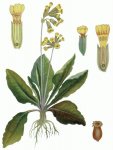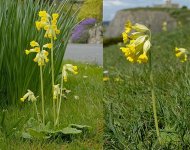Spring primrose
Primula veris L.
Botanical characteristics. The family is primrose. A perennial herbaceous plant 15-30 cm in height. It has a scaly rhizome, from which white cord-like roots leave. The leaves are collected in a rosette rosette, ovate-long, wrinkled, wavy at the edges. The whole plant is covered with velvety fluff. Blooms from mid-April to June. Bright yellow flowers are collected at the top of the flower arrow in the inflorescence umbrellas. The peculiarity of the flowers of the primrose is their heterogeneity (heterostyles). Fruits - numerous egg-shaped boxes - ripen in July.
Spread. Early spring blossoms in meadows, on the slopes of hills, in broad-leaved and mixed forests, among thickets of shrubs. Distributed in the south of the forest and in the forest-steppe zones of the European part of Russia, the Urals, Western Siberia, the Crimea and the Caucasus.
Used parts of the plant.
The above-ground part with flowers.
The plant contains saponins (5-10%) and phenolic glycosides (primulaveroside and imbricoside). The chemical composition of the primrose is not well understood.
Application.
Primrose contains a large amount of vitamin C and in the spring it is used for food in the form of salads.
The dried plant is prescribed for various colds: influenza, angina, bronchitis, in polynomia and rhino sinusitis.
Primula has a mild sedative and hypnotic effect, it helps with migraines, neuroses and insomnia (better in a mixture with other plants).
Preparation. Infusion: 2-3 tablespoons of herbs pour 0.5 liters of boiling water (in a thermos) - a daily dose.




Comments
Commenting on, remember that the content and tone of your message can hurt the feelings of real people, show respect and tolerance to your interlocutors even if you do not share their opinion, your behavior in the conditions of freedom of expression and anonymity provided by the Internet, changes Not only virtual, but also the real world. All comments are hidden from the index, spam is controlled.